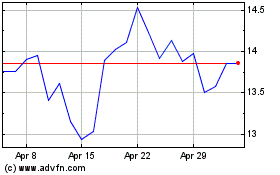Regulators Probe Jet That Touched Down Short of Charlotte Runway
August 17 2015 - 11:50PM
Dow Jones News
Federal air-safety officials are looking into an American
Airlines jet that damaged the underside of its tail while trying to
land at the Charlotte, N.C., international airport over the
weekend, in a highly unusual incident the pilots attributed to wind
shear.
The Airbus A321 en route from Atlanta with 159 people aboard
smashed into several approach and runway lights Saturday night,
climbed away from the strip and then landed safely on a second
attempt, according to the Federal Aviation Administration. There
were no injuries, but the event has prompted scrutiny from
government and industry safety experts.
Over the weekend, an agency spokesman said the FAA was
investigating, adding that the cockpit crew reported that shortly
before touchdown the twin-engine, single-aisle aircraft experienced
a wind shear—sometimes referred to as a microburst—which can cause
a sudden and violent shift in wind direction relatively close to
the ground.
The airport temporarily closed the runway after workers found
debris on the strip, according to the FAA. The plane touched down
short of the runway, according to one person familiar with the
details, and the plane's black box recorders, containing flight
data and cockpit conversations, are in government custody.
On Monday, American Airlines Group confirmed that after landing,
the captain of Flight 1851, operated by US Airways, "discovered
damage to the belly of the aircraft" and the plane was taken out of
service.
American said it reported the incident to both the FAA and the
National Transportation Safety Board. A spokeswoman for the carrier
declined to provide additional details, citing the safety board's
involvement. An NTSB spokesman had no immediate comment.
Airliner mishaps during landing or takeoff attributed to wind
shear are almost unheard of in the U.S. these days as a result of
enhanced radar systems and training for pilots on how to avoid and
safely escape such dangerous weather phenomena.
Crews also must comply with safety rules at individual airlines,
mandating landing pilots to execute a go-around if their planes
aren't stabilized during the final phases of the approach with the
proper speed, altitude and orientation relative to the ground.
The last major wind-shear accident in this country involving a
commercial jet occurred at the same airport more than 21 years ago,
when a McDonnell Douglas DC-9, operated by what was then called
USAir, plowed into a field near the airport after it was caught in
a violent downdraft spawned by a thunderstorm.
For American, the latest mishap is the second time in about a
year that a cockpit crew's airmanship has prompted heightened
scrutiny from government and industry safety experts.
In August of last year, an American Boeing 757, cruising at
35,000 feet over Venezuela, lost some 7,500 feet of altitude in
about one minute. There were no injuries and the flight continued
on to Brazil, but the incident was unusual enough to be noticed and
analyzed by safety experts for months afterward. Some outside
experts described the incident as a high-altitude stall. Airline
officials subsequently said the cockpit crew failed to maintain
speed and engine thrust appropriate to the flight conditions, but
declined to provide further details.
The Charlotte event will be classified as an incident or more
serious accident once the Airbus jet is inspected and repairs
commence, depending on what engineers determine is the extent of
damage to the aircraft's structure.
Write to Andy Pasztor at andy.pasztor@wsj.com
Subscribe to WSJ: http://online.wsj.com?mod=djnwires
(END) Dow Jones Newswires
August 17, 2015 23:35 ET (03:35 GMT)
Copyright (c) 2015 Dow Jones & Company, Inc.
American Airlines (NASDAQ:AAL)
Historical Stock Chart
From Mar 2024 to Apr 2024

American Airlines (NASDAQ:AAL)
Historical Stock Chart
From Apr 2023 to Apr 2024
